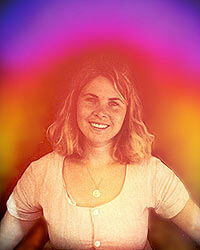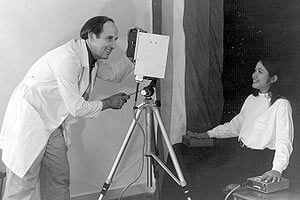Photographing the Aura with Electronic Technology
by C.E. Lindgren
Man has documented auras for over 5,000 years. Although the auras vary in description and supposed origin, Eastern Indian, Chinese, Jewish and Christian mystics have alluded to this phenomena as energies vibrating through all physical matter. According to psychics, these energies are divided into colors (i.e., red, orange, yellow, green, turquoise, blue, purple and pink) and fields (etheric, emotional, mental, astral, etheric template, celestial and ketheric).
One of the earliest attempts at photographing an aura occurred in the 1890s when Nicola Tesla produced the first “aura photograph.” Since then, there have been many attempts at producing photographic proof of auric energy. In the late 1930s, Kirlian (high-voltage imaging process) photography was introduced. This form of radiation field photography was introduced by Semyon and Valentina Kirlian and later researched by V.M. Inyushin, and Victor Adamenko. According to some researchers, in this procedure an individual using photographic means, is able to record energy being produced by the body. This technique uses electric current exposing the presence of energy patterns which are then transferred to a photographic plate. Researchers are still divided in their opinions of the Kirlian phenomena. Some call the manifestation corona discharge, believing the procedure only records routine electrical manifestations, while others see radiation field photography as decloaking the “bioplasma body” or aura.
Aura Imaging Photography
Today there is a new form of aura photography far superior to Kirlian’s energy transfer photography. Known as Aura Imaging Photography, this technique captures aura images by producing a full-spectrum color print of remote bioplasmic energy transfer. The resulting photographs show the upper segment of the subject’s body including the head, neck, and shoulders. Experimentation is currently underway toward producing a full-body perimeter electrofield image. This system utilizes traditional biofeedback measuring combined with high voltage field imaging. The camera displays inputs as colorful light fields surrounding the body, enabling quicker recognition by the researcher. Explore the auraphoto book color key to get a deeper understanding of what each color means.
A researcher and designer in this new technology is Guy Coggins, inventor of the AuraCamera 6000, which he introduced in 1992. The AuraCamera 6000, according to Coggins, does not actually “see” auras, rather it displays depictions of them electronically. This camera is state of the art in instant film aura depiction with unparalleled quality.

Subject with aura. Used by permission of Guy Coggins and the Progen Company.
A subject, while sitting, is asked to place his/her hands on a probe which transmits a radio frequency through the subject. According to Coggins, the body becomes a “living antenna.” The energy produced by this “human antenna” is received by a complex series of receiver-scanners located in an array behind the subject. Each probe has a unique receiver wired through a high speed multiplexer. The collected data is then delivered to a computer system where it is processed and displayed as electromagnetic energy (i.e., light and sound).
The Future
Although still experimental, Aura Imaging technology has been widely used. As a parapsychological tool, the instrument seems to verify readings made by certain psychics and mediums. According to Coggins, the camera also “showed comparative differences and improvements in a patient’s energy field in ‘before’ and ‘after’ photos taken during healing and counseling sessions.” The healing in these cases was performed by psychic or chakra healers. In this setting, a photograph was taken before the healing session and again after the psychic activated a specific chakra or energy center in the subject’s body (one that according to the practitioner was causing the physical or emotional problem). When rephotographed, there appeared to be significant increases in amplitude and frequency of the electric field over the subject’s chakra.

Coggins, camera and subject. Used by permission of Guy Coggins and the Progen Company.
Although one can’t forecast the future benefits of this technique, there is hope the instrument may well find utility as an optional diagnostic tool. Much of its initial usage has been in nontradi-tional medical or health settings. It is hoped, however, that in time traditional medicine may find a use for this innovative technology.
*By permission of publisher, certain concepts and statements were taken from an article, written by the author, which first appeared in the January, 1995 issue of Fate magazine.
Explore the aura photography book to learn more about its aura imaging book contents.
